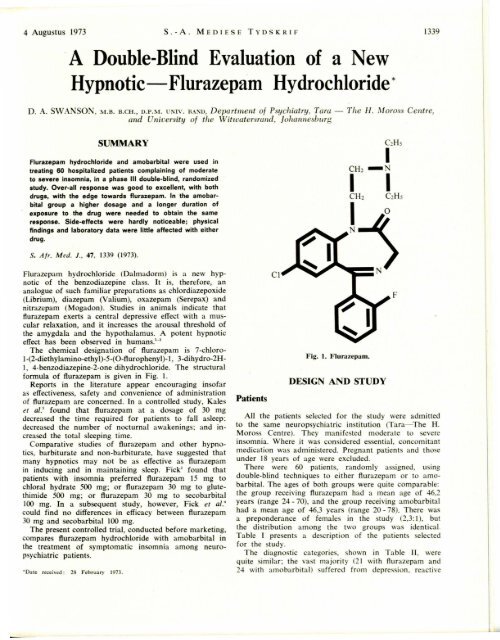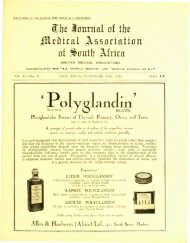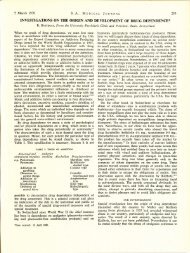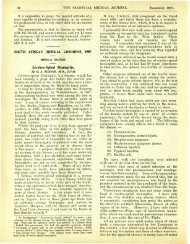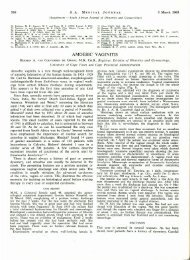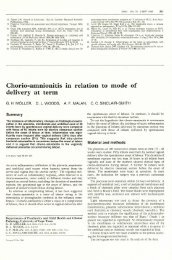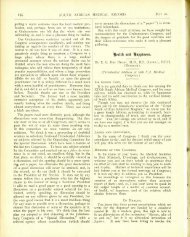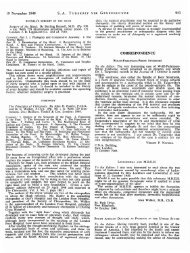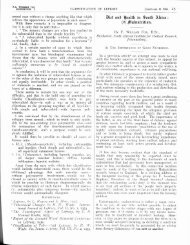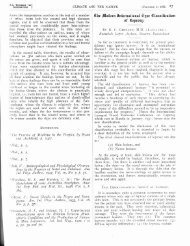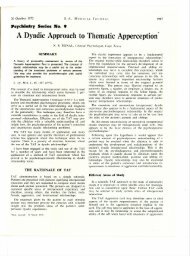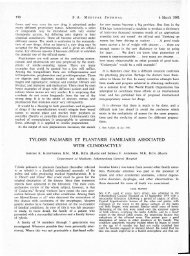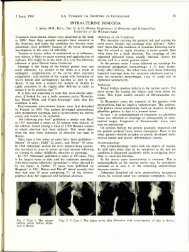1.3 A DOUBLE-BLIND EVALUATION OF A NEW HYPNOTIC
1.3 A DOUBLE-BLIND EVALUATION OF A NEW HYPNOTIC
1.3 A DOUBLE-BLIND EVALUATION OF A NEW HYPNOTIC
You also want an ePaper? Increase the reach of your titles
YUMPU automatically turns print PDFs into web optimized ePapers that Google loves.
4 Augustus 1973 S.-A. MEDIESE TVDSKRIF 1339<br />
.A Double-Blind Evaluation of a New<br />
Hypnotic-Flurazepam Hydrochloride *<br />
D. A. SWANSON, l\LB. B.eR., D.P.M. UNI\'. RAND, Department of Psychiatry, Tara - The H. Morass Centre,<br />
and University of the Witwatersrand, Johannesburg<br />
SUMMARY<br />
Flurazepam hydrochloride and amobarbital were used in<br />
treating 60 hospitalized patients complaining of moderate<br />
to severe insomnia, in a phase III double-blind, randomized<br />
study. Over-all response was good to excellent, with both<br />
drugs, with the edge towards f1urazepam. In the amobarbital<br />
group a higher dosage and a longer duration of<br />
exposure to the drug were needed to obtain the same<br />
response. Side-effects were hardly noticeable; physical<br />
findings and laboratory data were little affected with either<br />
drug.<br />
s. Afr. Med. l .. 47, 1339 (1973).<br />
Flurazepam hydrochloride (Dalmadorm) is a new hypnotic<br />
of the benzodiazepine class. It is, therefore, an<br />
analogue of such familiar preparations as chlordiazepoxide<br />
(Librium), diazepam (Valium), oxazepam (Serepax) and<br />
nitrazepam (Mogadon). Studies in animals indicate that<br />
f1urazepam exerts a centn\1 depressive effect with a muscular<br />
relaxation, and it increases the arousal threshold of<br />
the amygdala and thehypothalamus. A potent hypnotic<br />
effect has been observed in humans.'"<br />
The chemical designation of flurazepam is 7-chloro<br />
1-(2-diethylamino-ethyl)-5-(O-flurophenyl)-I, 3-dihydro-2H<br />
), 4·benzodiazepine-2-one dihydrochloride. The structural<br />
formula of flurazepam is given in Fig. 1.<br />
Reports in the literature appear encouraging insofar<br />
as effectiveness, safety and convenience of administration<br />
of flurazepam are concerned. ]n a controlled study, Kales<br />
et al.' found that flurazepam at a dosage of 30 mg<br />
decreased the time required for patients to fall asleep:<br />
decreased the number of nocturnal awakenings; and increased<br />
the total sleeping time.<br />
Comparative studies of flurazepam and other hypnotics,<br />
barbiturate and non-barbiturate, have suggested that<br />
many hypnotics may not be as effective as flurazepam<br />
in inducing and in maintaining sleep. Fick' found that<br />
patients with insomnia preferred flurazepam 15 mg to<br />
chloral hydrate 500 mg; or flurazeparn 30 mg to glutethimide<br />
500 mg; or flurazepam 30 rng to secobarbital<br />
100 mg. In a subsequent study, however, Fick et aI.'<br />
could find no differences in efficacy between flurazepam<br />
30 mg and secobarbital 100 mg.<br />
The present controlled trial, conducted before marketing,<br />
compares flurazepam hydrochloride with amobarbital in<br />
the treatment of symptomatic insomnia among neuropsychiatric<br />
patients.<br />
'Date received: 28 February 1973.<br />
Patients<br />
Cl<br />
Fig. 1. Flurazepam.<br />
DESIGN AND STUDY<br />
All the patients selected for the study were admitted<br />
to the same neuropsychiatric institution (Tara-The H.<br />
Moross Centre). They manifested moderate to severe<br />
insomnia. Where it was considered essential, concomitant<br />
medication was administered. Pregnant patients and those<br />
under 18 years of age were excluded.<br />
There were 60 patients, randomly assigned, using<br />
double-blind techniques to either flurazepam or to amobarbital.<br />
The ages of both groups were quite comparable:<br />
the group receiving flurazepam had a mean age of 46,2<br />
years (range 24 - 70), and the group receiving amobarbital<br />
had a mean age of 46,3 years (range 20 - 78). There was<br />
a preponderance of females in the study (2,3: 1), but<br />
the distribution among the two groups was identical.<br />
Table I presents a description of the patients selected<br />
for the study.<br />
The diagnostic categories, shown in Table H, were<br />
quite similar; the vast majority (21 with f1urazepam and<br />
24 with amobarbital) suffered from depression, reactive
1340 S.A. MEDICAL JOURNAL 4 August 1973<br />
TABLE I.<br />
No. of patients<br />
Sex<br />
Male<br />
Female ...<br />
Average age (range)<br />
Marital status<br />
Single ._<br />
Married<br />
Divorced/separated/<br />
widowed ..<br />
Concomitant medication<br />
Yes<br />
No<br />
DESCRIPTION <strong>OF</strong> PATIENTS<br />
Treatment groups<br />
Flurazepam Amobarbital<br />
30 30'<br />
.. Two patients from this group were withdrawn. one after an at·<br />
tempted suicide, and the other because of suspected porphyria.<br />
g<br />
21 21<br />
46,2 (24 - 70) 46,3 (20 - 78)<br />
g<br />
3 8<br />
18 16<br />
g 6<br />
18 23<br />
12 7<br />
administered 30 - 60 minutes before bedtime to all the<br />
selected patients. To start with a single capsule was<br />
given; the dosage being increased by 1 capsule on the<br />
following night to a final dose of 3 capsules, if the<br />
insomnia remained unaltered. either tbe patient, nor<br />
the nursing staff, nor the investigator knew which was<br />
administered until the code was broken at the end of<br />
the study.<br />
Two patients were withdrawn from the study: one<br />
when it was suspected that she was suffering from<br />
porphyria; and the other after he had attempted suicide.<br />
When the code was broken at the end of the study.<br />
both were receiving amobarbital.<br />
RESULTS<br />
The over-all (global) therapeutic response, as - evaluated<br />
at the conclusion of treatment in each patient, is presented<br />
in Table Ill. The efficacy ratings for each of the comor<br />
endogenous. The endogenous depressive group included<br />
those patients who manifested either the unipolar or<br />
the bipolar form (i.e. tbose wbo had both manic and<br />
depressive phases). The remaining patients fell into a<br />
heterogeneous group of neuropsychiatric conditions.<br />
TABLE 11. DIAGNOSTIC CATEGORIES<br />
Treatment groups<br />
TABLE Ill. GLOBAL THERAPEUTIC RESPONSE RATING<br />
Flurazepam<br />
Amobarbital<br />
Over-all<br />
response Doctor Patient Doctor Patient<br />
Very good 21 22 13 15<br />
Good 7 8 10 7<br />
Moderate 2 Q 4 4<br />
No effect 0 0 1 2<br />
Worse 0 0 0 0<br />
Diagnoses<br />
Reactive depression<br />
Endogenous depression<br />
Schizo-affective disorder<br />
Schizophrenia<br />
Anxiety reaction<br />
Myasthenia gravis<br />
Presenile dementia<br />
Involutional psychosis<br />
Obsessional personality<br />
Psychopathic personality<br />
Flurazepam<br />
8<br />
13<br />
3<br />
2<br />
1<br />
1<br />
o<br />
2<br />
o<br />
o<br />
Total 30<br />
Amobarbital<br />
4<br />
20'<br />
1<br />
2<br />
o<br />
o<br />
1<br />
o<br />
1<br />
1<br />
30<br />
parison drugs shows a bias towards flurazepam. This<br />
becomes more evident when the dosage which provided<br />
the optimum response is analysed. With flurazepam the<br />
majority of patients (800~-24 patients) required only<br />
30 mg (1 capsule) to effect a good .response, and the<br />
remainder (20°{,-6 patients) required 60 mg (2 capsules).<br />
The distribution with amobarbital was more attenuated:<br />
46,4% (13 patients) requiring 50 mg (l capsule); 25%<br />
(7 patients) requiring 100 mg (2 capsules); and the<br />
remaining 28,6')0 (8 patients) requiring 150 mg (3 capsules).<br />
Table IV shows the optimum response per dosage<br />
ratio.<br />
• Includes 2 patients withdrawn from study. TABLE IV. DOSAGE RESPONSE<br />
Procedure<br />
The study period was 2 weeks: I week of observation<br />
before medication was begun (baseline period) followed<br />
by I week (7 nights) of treatment. On the morning<br />
before starting medication and on each subsequent morning<br />
of the trial period, patients were interviewed as to<br />
(a) time required to fall asleep; (b) duration of sleep;<br />
(c) condition upon awakening; and (d) any adverse<br />
reactions.<br />
A mndomized. double-blind method of study, statistically<br />
generated, was employed. Flurazepam (30 mg) or<br />
amobarbital (50 mg) in matching gelatin capsules was<br />
Flurazepam<br />
Amobarbital<br />
1 tab<br />
24 (80%)<br />
13 (46,4/'0)<br />
Dosage<br />
2 tabs<br />
6 (20/'0)<br />
7 (25%)<br />
3 tabs<br />
o<br />
8 (28,6/'0)<br />
A comparison of the effects of both trial substances on<br />
sleep induction and duration is shown schematicaIly in<br />
Fig. 2. The results indicate that flurazepam is more<br />
effective for inducing and maintaining sleep. Approximately<br />
60% (19 patients) receiving flurazepam showed<br />
an immediate and sustained response on both parameters,<br />
whereas with amobarbital the response rates were much<br />
lower. In the amobarbital group an immediate response
4 Augustus 1973 S.-A. MEDIESE TVDSKRIF 1341<br />
for sleep induction occurred in 35~~ (7 patients), while<br />
the duration of sleep was less sustained in 37,5"'0 (10<br />
patients).<br />
Number of 20<br />
patients<br />
15<br />
SLEEP INDUCTION<br />
---- Flurazepam<br />
- - - - - - - Amobarbital<br />
Both groups of patients reported similar states on<br />
awakening and tills appeared to be directly related to the<br />
dosage of the particular drug and the response to that<br />
dosage.<br />
No serious adver e reactions to medication were reported.<br />
With f1urazepam 9 patients complained of mild<br />
drowsiness and 2 patients reported having had nightmares.<br />
Of those patients receiving amobarbital, 4 complained of<br />
drowsiness. while 2 others reported marked drowsines<br />
which was interpreted as a 'hangover' effect on awakening.<br />
In both study group these reactions did not appear to<br />
be dose-related.<br />
10<br />
" ,<br />
,-<br />
DISCUSSION<br />
5<br />
Number of 20<br />
patients<br />
15<br />
0 1 2 3 4<br />
Day when onset 20 minutes<br />
SLEEP DURATION<br />
I<br />
10 I<br />
I<br />
I<br />
I<br />
5<br />
I<br />
/<br />
/<br />
_L--<br />
0 2 3 4<br />
Day when duration 6 hours<br />
Fig. 2. Sleep induction and duration.<br />
This study utilized the subjective evaluation of patients,<br />
wlllch was interpreted as a 'hangover' effect on awakening.<br />
effective single method for assessing the hypnotic potency<br />
of drugs'"<br />
In this particular double-blind study of f1urazepam<br />
hydrochloride with amobarbital controls, the results indicate<br />
that f1urazepam is effective for inducing and maintaining<br />
sleep in patients with insomnia. Most patients<br />
felt rested and alert on awakening; they tended to get<br />
to sleep more quickly; to sleep better and longer than on<br />
amobarbital.<br />
Conclusions from this subjective comparative study agree<br />
with those obtained in other studies regarding the efficacy<br />
of f1urazepam for the induction and maintenance of sleep<br />
in subjects with insomnia:"<br />
T should like to thank Dr B. de Wet for his help and advice;<br />
and Roche Products (Pty) Ltd, Isando, for supplying the drugs.<br />
REFERENCES<br />
I. Department of Clinical Research, Roche Laboratories, lsando. Tvl:<br />
Unpublished data.<br />
2. Fick, H. (t967): CUrT. Thee. Res.• 9. 355.<br />
3. Kales, A., Tan, L. T., Scharf, M., Kales, J. and Malmstrom, E.<br />
(1969): Psychophysiology, 6. 260.<br />
4. Fick. H. (1972): J. Clin. Pharmacol., 12. 2t7.<br />
5. Z mmerman. A. M. (1971): Curr. Ther. Res., 13, 18.<br />
6. Hare, E. H. (1955) Brit. J. Prey. Soc. Med., 9, t40.<br />
7. Exton-Smith, A. N., Hodkinson, H. M. and Cromie, B. W. (1963): Brit.<br />
Med. J., 2, 1037.


